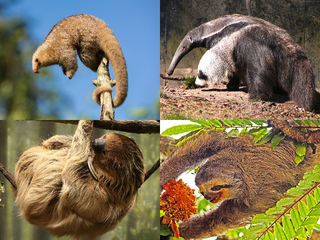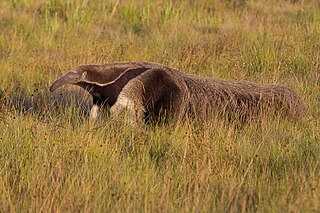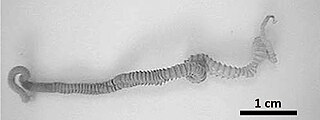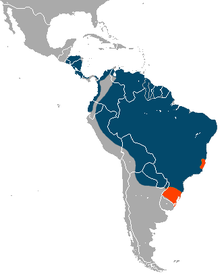
Xenarthra is a major clade of placental mammals native to the Americas. There are 31 living species: the anteaters, tree sloths, and armadillos. Extinct xenarthrans include the glyptodonts, pampatheres and ground sloths. Xenarthrans originated in South America during the late Paleocene about 60 million years ago. They evolved and diversified extensively in South America during the continent's long period of isolation in the early to mid Cenozoic Era. They spread to the Antilles by the early Miocene and, starting about 3 million years ago, spread to Central and North America as part of the Great American Interchange. Nearly all of the formerly abundant megafaunal xenarthrans became extinct at the end of the Pleistocene.

Megatherium is an extinct genus of ground sloths endemic to South America that lived from the Early Pliocene through the end of the Pleistocene. It is best known for the elephant-sized type species M. americanum, sometimes known as the giant ground sloth, or the megathere, native to the Pampas through southern Bolivia during the Pleistocene. Various other smaller species belonging to the subgenus Pseudomegatherium are known from the Andes.

The silky anteater, also known as the pygmy anteater, has traditionally been considered a single species of anteater, Cyclopes didactylus, in the genus Cyclopes, the only living genus in the family Cyclopedidae. Found in southern Mexico, and Central and South America, it is the smallest of all known anteaters. It has nocturnal habits and appears to be completely arboreal; its hind feet are highly modified for climbing.

The southern tamandua, also called the collared anteater or lesser anteater, is a species of anteater from South America and the island of Trinidad in the Caribbean. It is a solitary animal found in many habitats, from mature to highly disturbed secondary forests and arid savannas. It feeds on ants, termites, and bees. Its very strong foreclaws can be used to break insect nests or to defend itself.

The brown four-eyed opossum is a pouchless marsupial of the family Didelphidae. It is found in different forested habitats of Central and South America, from Nicaragua to Brazil and northern Argentina, including southeastern Colombia, Paraguay and eastern Peru and Bolivia, at elevations from sea level to 1,500 m (4,900 ft). It is the only recognized species in the genus Metachirus, but molecular phylogenetics studies suggest that it should probably be split into several species. Population densities are usually low, and it is uncommon in parts of Central America. A density of 25.6/km2 (66/sq mi) was reported near Manaus, Brazil. Its karyotype has 2n = 14 and FN = 24.

The order Pilosa is a clade of xenarthran placental mammals, native to the Americas. It includes anteaters and sloths. The name comes from the Latin word for "hairy".

The Myrmecophagidae are a family of anteaters, the name being derived from the Ancient Greek words for 'ant' and 'eat'. Two genera and three species are in the family, consisting of the giant anteater, and the tamanduas. The fossil Eurotamandua from the Messel Pit in Germany may be an early anteater, but its status is currently debated.
Archiacanthocephala is a class within the phylum of Acanthocephala. They are parasitic worms that attach themselves to the intestinal wall of terrestrial vertebrates, including humans. They are characterised by the body wall and the lemnisci, which have nuclei that divide without spindle formation, or the appearance of chromosomes, or it has a few amoebae-like giant nuclei. Typically, there are eight separate cement glands in the male, which is one of the few ways to distinguish the dorsal and ventral sides of these organisms.

Eurotamandua is an extinct genus of mammal from extinct family Eurotamanduidae that lived during the middle Eocene.

Tamandua is a genus of anteaters in the Myrmecophagidae family with two species: the southern tamandua and the northern tamandua. They live in forests and grasslands, are semiarboreal, and possess partially prehensile tails. They mainly eat ants and termites, but they occasionally eat bees, beetles, and insect larvae. In captivity, they will eat fruits and meat. They have no teeth and depend on their powerful gizzards to break down their food.

The northern tamandua is a species of tamandua, an anteater in the family Myrmecophagidae. They live in tropical and subtropical forests from southern Mexico, through Central America, and to the edge of the northern Andes.

Anteaters are the four extant mammal species in the suborder Vermilingua, commonly known for eating ants and termites. The individual species have other names in English and other languages. Together with sloths, they are within the order Pilosa. The name "anteater" is also commonly applied to the unrelated aardvark, numbat, echidnas, and pangolins, although they are not closely related to them.

Gigantorhynchida is an order containing a single family, Gigantorhynchidae of Acanthocephala that parasitize vertebrates by attaching themselves to the intestinal wall of their host. There are over 60 species classified into three genera in GigantorhynchidaGigantorhynchus, Intraproboscis, and Mediorhynchus.

Gigantorhynchus is a genus of Acanthocephala that parasitize marsupials, anteaters, and possibly baboons by attaching themselves to the intestines using their hook-covered proboscis. Their life cycle includes an egg stage found in host feces, a cystacanth (larval) stage in an intermediate host such as termites, and an adult stage where cystacanths mature in the intestines of the host. This genus is characterized by a cylindrical proboscis with a crown of robust hooks at the apex followed by numerous small hooks on the rest of the proboscis, a long body with pseudosegmentation, filiform lemnisci, and ellipsoid testes. The largest known specimen is the female G. ortizi with a length of around 240 millimetres (9.4 in) and a width of 2 millimetres (0.08 in). Genetic analysis on one species of Gigantorhynchus places it with the related genus Mediorhynchus in the family Gigantorhynchidae. Six species in this genus are distributed across Central and South America and possibly Zimbabwe. Infestation by a Gigantorhynchus species may cause partial obstructions of the intestines, severe lesions of the intestinal wall, and may lead to death.
The mammalian order Pilosa, which includes the sloths and anteaters, includes various species from the Caribbean region. Many species of sloths are known from the Greater Antilles, all of which became extinct over the last millennia, but some sloths and anteaters survive on islands closer to the mainland.

Neotamandua is an extinct genus of anteaters that lived in the Miocene to Pliocene in South America.

Protamandua is an extinct genus of anteaters. Its closest living relatives are the giant anteater and tamanduas. Fossils of Protamandua are restricted to the Santa Cruz Formation of Argentina. It may have been a common ancestor of Myrmecophaga and Tamandua.
Amblyomma nodosum is a species of specialized tick, found in three roadkilled giant anteaters from Minas Gerais, Brazil. There are 100 species of Amblyomma worldwide, 33 of which are from Brazil. A. nodosum is a specialist that lives exclusively on the giant anteater and the Southern tamandua.
Neoncicola is a genus of parasitic worms containing nine species and belongs to the family Oligacanthorhynchidae.




























